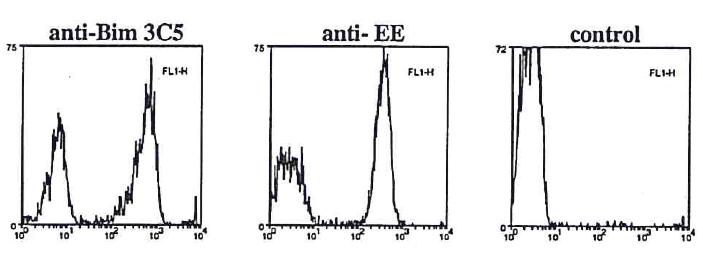anti-BimS/EL/L mAb (3C5)
| Code | Size | Price |
|---|
| AG-20T-0142-C100 | 100 ug | £300.00 |
Quantity:
Prices exclude any Taxes / VAT
Overview
Antibody Clonality: Monoclonal
Regulatory Status: RUO
Target Species: Multiple species
Applications:
- Enzyme-Linked Immunosorbent Assay (ELISA)
- Flow Cytometry
- Immunocytochemistry (ICC)
- Immunohistochemistry (IHC)
- Immunoprecipitation (IP)
- Western Blot (WB)
Shipping:
-20°C
Storage:
-20°C
Images
Documents
Further Information
Alternate Names/Synonyms:
BCL2L11; Bcl-2-like Protein 11; Bcl2-interacting Mediator of Cell Death
Concentration:
1mg/ml
EClass:
32160000
Endotoxin:
<0.1EU/µg purified protein (LAL test; Lonza).
Form (Short):
liquid
Formulation:
Liquid. In PBS containing 0.02% sodium azide and 25% glycerol.
Handling Advice:
After opening, prepare aliquots and store at -20°C.Avoid freeze/thaw cycles.
Immunogen:
Synthetic peptide corresponding to aa 20-40 of mouse BimL.
Long Description:
Monoclonal Antibody. Recognizes an epitope within aa 20-40 of human, mouse, rat, monkey and dog BimL (~19kDa), BimEL (~23kDa), and BimS (~16kDa). Also recognizes the six novel isoforms of human Bim, generated by alternative splicing and lacking the C-terminal hydrophobic region. Isotype: Rat IgG2akappa. Clone: 3C5. Applications: ELISA, FACS, ICC, IHC, IP, WB. Liquid. In PBS containing 0.02% sodium azide and 25% glycerol. Bim belongs to the Bcl-2 protein family. Bcl-2 family members form hetero- or homodimers and act as anti- or pro-apoptotic regulators that are involved in a wide variety of cellular activities. This protein contains a Bcl-2 homology domain 3 (BH3). It has been shown to interact with other members of the Bcl-2 protein family (BCL2, BCL2L1/BCL-X(L) and MCL1) and to act as an apoptotic activator, inducing apoptosis and anoikis. Several variants have been identified. The isoforms vary in cytotoxicity with isoform BimS being the most potent and isoform BimEL being the least potent.
Package Type:
Plastic Vial
Product Description:
Bim belongs to the Bcl-2 protein family. Bcl-2 family members form hetero- or homodimers and act as anti- or pro-apoptotic regulators that are involved in a wide variety of cellular activities. This protein contains a Bcl-2 homology domain 3 (BH3). It has been shown to interact with other members of the Bcl-2 protein family (BCL2, BCL2L1/BCL-X(L) and MCL1) and to act as an apoptotic activator, inducing apoptosis and anoikis. Several variants have been identified. The isoforms vary in cytotoxicity with isoform BimS being the most potent and isoform BimEL being the least potent.
Purity:
>95% (SDS-PAGE)
Specificity:
Recognizes an epitope within aa 20-40 of human, mouse, rat, monkey and dog BimL (~19kDa), BimEL (~23kDa), and BimS (~16kDa). Also recognizes the six novel isoforms of human Bim, generated by alternative splicing and lacking the C-terminal hydrophobic region.
Transportation:
Non-hazardous
UNSPSC Category:
Primary Antibodies
UNSPSC Number:
12352203
Use & Stability:
Stable for at least 1 year after receipt when stored at -20°C.
References
Generalized resistance to thymic deletion in the NOD mouse; a polygenic trait characterized by defective induction of Bim: A. Liston, et al.; Immunity 21, 817 (2004) | Bim is a suppressor of Myc-induced mouse B cell leukemia: A. Eagle, et al.; PNAS 101, 6164 (2004) | ER stress triggers apoptosis by activating BH3-only protein Bim: H. Puthalakath, et al.; Cell 129, 1337 (2007) | BimS-induced apoptosis requires mitochondrial localization but not interaction with anti-apoptotic Bcl-2 proteins: A. Weber, et al.; J. Cell Biol. 177, 625 (2007) | NF-kappaB1 and c-Rel cooperate to promote the survival of TLR4-activated B cells by neutralizing Bim via distinct mechanisms: A. Banerjee, et al.; Blood 112, 5063 (2008) | Loss of the BH3-only protein Bmf impairs B cell homeostasis and accelerates gamma irradiation-induced thymic lymphoma development: V. Labi, et al.; J. Exp. Med. 205, 641 (2008) | MEK/ERK-Mediated Phosphorylation of Bim is Required to Ensure Survival of T and B Lymphocytes during Mitogenic Stimulation: L.A. O'Reilly, et al.; J. Immunol. 183, 261 (2009) | c-Cbl promotes T cell receptor-induced thymocyte apoptosis by activating the phosphatidylinositol 3-kinase/Akt pathway: C.B. Thien, et al.; J. Biol. Chem. 285, 10969 (2010) | Targeting Activating Transcription Factor 3 by Galectin-9 Induces Apoptosis and Overcomes Various Types of Treatment Resistance in Chronic Myelogenous Leukemia: J. Kuroda, et al.; Mol. Cancer Res. 8, 994 (2010) | OCK8 deficiency impairs CD8 T cell survival and function in humans and mice: K.L. Randall, et al.; J. Exp. Med. 208, 2305 (2011) | Cyclic-AMP-dependent protein kinase A regulates apoptosis by stabilizing the BH3-only protein Bim: D. Moujalled, et al.; EMBO Rep. 12, 77 (2011) | Alternative splicing of Bim and Erk-mediated Bim(EL) phosphorylation are dispensable for hematopoietic homeostasis in vivo: C. Clybouw, et al.; Cell Death Differ. 19, 1060 (2012)



